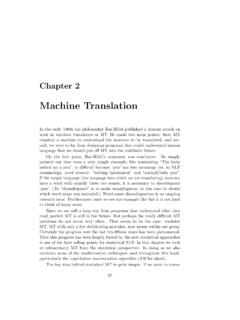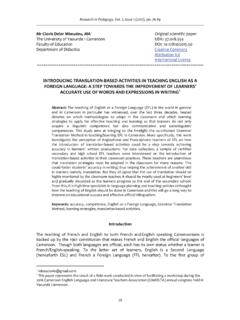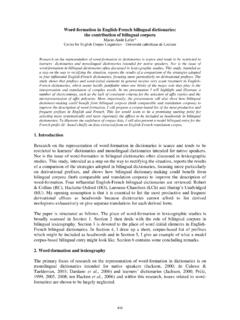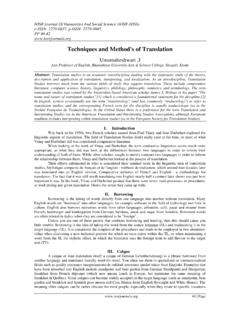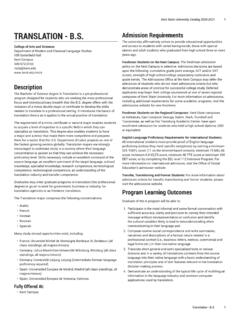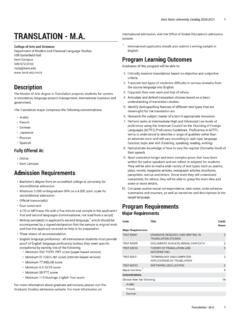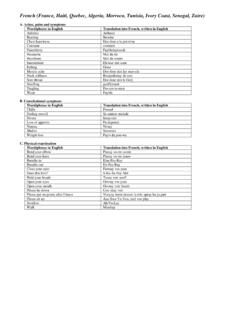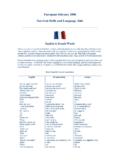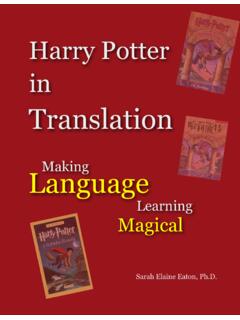Transcription of TRAG 150 TRANSLATIONS - University of California, Los Angeles
1 TRAG 150 TRANSLATIONS Use the translation table only when the main entry is a personal author or a title. Do not use for corporate or conference main entries. Do not use for belles-lettres. Consult the Subject Cataloging Manual: Shelflisting: G 220. TRANSLATIONS generally follow the original work alphabetically by language. They are distinguished from the original by adding digits representing a language from the LC translation table to the number of the original work: translation Table .x Original work .x16 Italian .x12 Polyglot .x162 Judeo-Arabic Afrikaans Kurdish Albanian Ladino Altai.
2 X163 Latin Amharic Latvian .x123 Arabic Lithuanian .x125 Armenian .x164 Macedonian Basque Norwegian Bulgarian .x165 Persian .x126 Byelorussian Polish Caucasian (Other) .x168 Portuguese Czech Pushto Danish .x169 Romanian .x128 Dutch.
3 X17 Russian .x13 English Serbo-Croatian (Cyrillic) Esperanto Serbo-Croatian (Roman) .x135 Estonian Slavic (Other) Finnish Slovak .x14 french Slovenian .x145 Georgian .x18 Spanish .x15 German .x184 Swedish .x153 Greek .x185 Turkish.
4 X155 Hebrew Ukrainian Hungarian Urdu Icelandic .x188 Yiddish The above is a somewhat expanded version of the LC translation table, to be used flexibly. If there is a special place indicated for TRANSLATIONS in the Master set of the LC classification schedules, follow it. URL Cataloging Department March 1995 1 Subject Cataloging manuals: Shelflisting G 150 TranslationsG 150 BACKGROUND: A translation is a rendering from one language into another, or from an older form of a language into a modern form, more or less closely following the original. A translation can be identified in a bibliographic record by the presence of a uniform title with the addition of a language or languages at the end.
5 The Library of Congress uses a translation Table when Cuttering for a translation . TRANSLATIONS generally follow the original work in alphabetical order by language. Prior to 1983, if there was an indication that the work was a translation either in the statement of responsibility in the body of the entry, or the cataloger indicated that a uniform title was not available, the translation Table was applied. This practice was discontinued in 1983. This instruction sheet provides guidelines for the proper Cuttering of TRANSLATIONS . translation TABLE .x .x12 .x13 .x14 .x15 .x16 .x17 .x18 Original work polyglotPolyglot English translation french translation German translation Italian translation Russian translation Spanish translation PROCEDURES: 1. Use the translation Table when Cuttering for a translation only when a uniform title plus language(s) is provided and when the main entry is a personal author or title.
6 Do not use the translation Table for entries with a corporate or conference heading. Do not use the translation Table for autobiographies or correspondence. 2. Distinguish TRANSLATIONS from the original work by using the Cutter of the original work modified by the application of the translation Table. 3. If two languages are named in the uniform title, Cutter for the first language. 4. If a language is not listed on the translation Table, select a number for that language that would agree alphabetically with the table and any translation (s) previously shelflisted in the same class. For example, if a German translation is already shelflisted on .x15, a Hebrew translation could be .x16, Portuguese .x17, etc. Example: DS117 .D8215 Dubnov, Semen Markovich, 1860-1941. 1925 [Vsemirnaia istoriia evreiskogo naroda. German] Weltgeschichte des judischen volkes, von .. 1925. DS117 .D8216 Dubnov, Semen Markovich, 1860-1941.
7 21958 [Vsemirnaia istoriia evreiskogo naroda. Hebrew] <Hebr> Divre yeme'am'olam. 1958. 5. Earlier practice. If the number one (1) was omitted from the number representing the translation ( , .x for the original work, .x3 for an English translation , .x4 for french , .x5 for German, etc.), continue this practice only when the pattern has already been established for that work. Use the translation Table without the number one (1). 6. When the caption By language, A-Z appears in the classification schedules, do not apply the translation Table. Instead, Cutter for the language itself, .E5 for English, .F7 for french , .G4 for German, etc. Example: Dungan .D86 Dusus .D87 Subject Cataloging Manual: Shelflisting Copyright (c)2004 by the Library of Congress except within the USA.
8 Copyright (c)2004 NextPage. All rights reserved. 3
